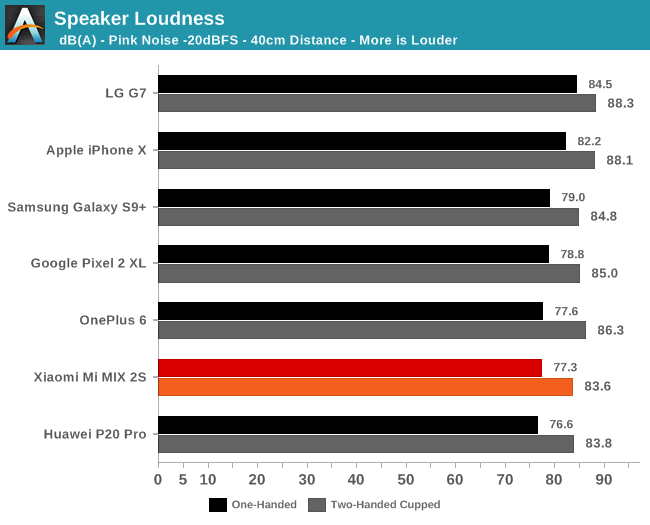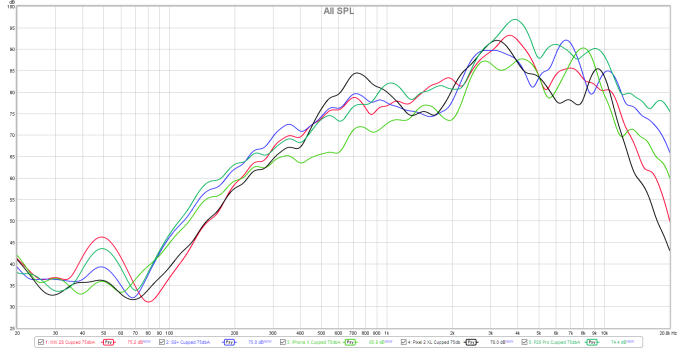The Xiaomi Mi MIX 2S Review: Fantastic Overall Value
by Andrei Frumusanu on June 29, 2018 8:00 AM EST- Posted in
- Mobile
- Smartphones
- Xiaomi
- MI MIX 2S
Camera Video Recording
The MIX 2S keeps it simple in terms of video recording modes, you have the option to shoot in 4K, 1080p, or 720p, all at 30fps with no 60fps option. High-frame-rate / slow-motion recording happens at up to 240fps at 1080p, and there’s a configurable time lapse mode with good settings ranging from 0.06s intervals up to 60s per frame. Xiaomi also offers the option to switch between H264/AVC and H265/HEVC in terms of video recording – notably the HEVC mode, while it does reduce file size by a bit, is seemingly used to actually increase the quality of the video more.
In terms of stabilisation, EIS, which is labelled as the “Stabiliser” function in the camera settings, is only active in 1080p and 720p modes. As is usual, while this mode produces a quite smooth stabilisation, it comes at a cost of reduced field of view as the sensor/ISP is reserving sufficient margins in the frame for the stabilisation window. This is a good quality EIS implementation as I’m having a hard time seeing any pixel scaling issues.
1080p and 4K recording without EIS is also adequate, although the OIS stabilisation isn’t as smooth as on Apple or Samsung devices and you can see the camera lens readjustment steps.
Image quality and exposure is excellent overall – the phone didn’t have any issues in terms of exposure adjustments between panning scenes, and auto-focus accuracy and speed was also virtually a non-issue. The 4K HEVC native capture was of excellent quality as it offered a 38Mbps stream in 5.1 High Profile – 10Mbps more than the Galaxy S9, the high bitrate in HEVC mode also comes at an overall increase quality over the AVC stream which came in at 42Mbps. I was also impressed with the clarity of the audio recorded, a big thumbs up.
One large issue that is notable in these samples is that the phone suffers from bad lens flare when facing the sun. It seems as though Xiaomi doesn’t have a good enough anti-reflective coating on the camera glass to reduce this.
No Video Recording on Zoom Module
I was curious how Xiaomi handled the transition on video recording between the camera modules when zooming. Unfortunately, there isn’t any transition and the telephoto camera is never used during video recording, and any zooming in is simply achieved through digital zoom on the main module.
Speaker Evaluation
Smartphone vendors seem to have put increased focus in trying to improve speaker audio quality in their designs, and this generation in particular we’ve seen some large improvements from Apple, Samsung and even LG put a great deal of focus on the speaker quality of the G7 (Review upcoming in the future).
I’ll be trying to improve our audio quality measurement methodology over the coming months, starting now with basic external speaker evaluations. The measurements are done on a calibrated flat response measurement microphone and I’m using REW as the supporting software.
Starting off with maximum speaker loudness measurements, we’re using a pink noise signal as the source. I’m opting to not use any kind of anechoic setup here as I feel that’s not a realistic use-case for smartphones and what we really want to measure is the perceived audio quality – and this can greatly differ on depending how you hold a phone. The scenarios I opted were simply holding the phone one-handed while seated down, with the measurement microphone next to my head, facing the phone at a 40cm distance – hopefully a setup that represents how most people use their phones. Added to that I also hold the phones two-handed and cup my palms, also hopefully a common use-case for people when watching content.

Among current flagships, the Mi MIX 2S at maximum volume doesn’t get as loud as the competition, but it’s not to say it’s a disappointing result. What I found the be the most detrimental to the MIX 2S is that the main speaker is very much downward firing, and this volume difference is very noticeable when compared to the iPhone X or say the S9. Cupping the MIX 2S helps a lot in redirecting the sound from the main speaker. The earpiece also operates in general audio playback, but the volume is pretty whimsical compared to other stereo speaker implementations from all other vendors.
Although volume is one aspect, what really defines perceived audio quality is the frequency response curve. All the phones were calibrated via pink noise to 75dB(A) and then, in cupped hands, I measured a logarithmic measurement sweep with REW. To simplify the graph and to better represent the audible differences between the phones, the curves have a psychoacoustic averaging filter applied to them.
The MIX 2S does not fare very well in the bass range at along with the Pixel 2 XL showcases the worst responses. The phone does well in the sub-bass range and this can be felt in the back of the phone vibrating, however that doesn’t really serve us in terms of audible sound. The Galaxy S9 and P20 Pro do best in the bass.
The MIX 2S recovers in the lower mid-range – and these are the important frequencies which give sound “depth”. Here the 2S catches up, while the iPhone X really suffers. It’s only after 450Hz where the Pixel 2 XL really gains back in volume, but this seems unbalanced compared to the lower frequency response it has.
In the mid-range frequencies all the phones are quite close together, and the MIX 2S actually avoid a dip that we see in other phones, aside from the iPhone X.
Moving into the higher mid-ranges, we see the disadvantages of having to deal with small speakers as here is where most of the volume is coming from. All phones have a peak between 3 and 4KHz, and starting from here till around 6KHz is what gives sound its “presence”.
In the lower high range commonly called treble, we see various peaks cross the phones as that’s what the speakers are most optimised in reproducing – ringtones.
Finally the higher frequencies above 8-10KHz is what gives sound its brilliance. Unfortunately the MIX 2S doesn’t fare well here as volume really drops off.
In general, what makes audio sound good is having the flattest possible response. In this case the MIX 2S has a good response between 500 and 10KHz, but suffers badly below and above that, giving the impression that it’s lacking depth as well as brilliance. Among all the phones, the Galaxy S9 produces the best overall audio because it manages to produce a lot more bass and low-mids, and equally really tries to maintain more of the high-treble. The Huawei P20 Pro would have been an outstanding competitor here, however the very large peaks in the presence range / high mids to low highs from 3-6KHz makes the sound a lot harsher than the S9.
I’m still experimenting with audio measurements, so I appreciate any feedback or suggestions and the methodology is certainly going to evolve more in the future. In particular I’m curious to see comments about reported volumes in dB(A) and db(C) and what one feels is more important.











61 Comments
View All Comments
nathanddrews - Friday, June 29, 2018 - link
Definitely seems like a great value, but I know I couldn't buy it without an OLED screen. How close to a stock experience does MIUI 9 provide? It doesn't look very intrusive at all, I like it.Andrei Frumusanu - Friday, June 29, 2018 - link
I'll be adding a software section in a short while - I've had zero issues with MIUI 9.5. Xiaomi also offers quite a novel gesture navigation method that works really well and gets rid of the navigation bar creating more screen real estate.Flunk - Friday, June 29, 2018 - link
It's not that novel, OnePlus offers a similar feature.close - Saturday, June 30, 2018 - link
Yeah, BlackBerry really used gestures a lot since the beginning of this decade, Apple took them and made them famous with the iPhone X, but now they are no longer novel because OnePlus/Android also copied them in 2018? :)arashi - Sunday, July 1, 2018 - link
You mean Nokia? With the N9?arashi - Sunday, July 1, 2018 - link
*that pioneered extensive gesture navigationSamus - Sunday, July 1, 2018 - link
Palm beat virtually everyone by a number of years to the gesture game. Give credit where credit is due. WebOS revolutionized mobile OS navigation and virtually every OS since had borrowed almost everything from multitasking cards to an information "hub" from WebOS.On top of all that, Palm beat Apple to wireless charging by an entire DECADE (unless you consider the Apple Watch, which by that means Palm beat them by 'just' 7 years.) Palm's wireless charging implementation was also significantly better than Qi from more efficient charging current (excluding Qualcomm high voltage fast charging) to magnetic alignment.
Lord of the Bored - Sunday, July 1, 2018 - link
But if we give credit where it is due, we can't give credit to Apple instead!piroroadkill - Monday, July 2, 2018 - link
It's actually kind of depressing to anyone who owned a Palm device with wireless charging how shoddy current wireless technologies are, and how few devices actually support it. The Pre and the Touchpad charged without any hassle whatsoever.hbsource - Monday, July 2, 2018 - link
Well, kind of.The little stand for the Pre was great but my screen always remained powered up while charging. The screen would be dark and blank but that was still more than enough to illuminate a dark bedroom.
The OS was very good but the hardware was definitely shonky. My keyboard rubber literally wore through to the metal below and I had a couple of incidents where I lost all the stored data and photos.
Could have been great but wasn't quite.